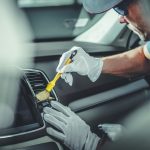How to Create a Comprehensive Car Maintenance Schedule
Coolant Checks and Changes
Coolant, or antifreeze, plays a vital role in temperature regulation within the engine. It prevents overheating in summer and freezing in winter. Regular checks ensure the coolant is at the recommended level and is neither too diluted nor too concentrated. A hydrometer can be used to check its effectiveness.
Coolant typically needs replacement every 30,000 to 50,000 miles. Old coolant can lose its protective properties and may cause rust within the engine. Flushing the coolant system as recommended maintains its efficacy and protects the engine from extreme temperatures and corrosion. Always use the coolant type specified in the vehicle’s manual.
Brake Fluid and Fuel Filter Inspection
Brake fluid transfers force into pressure, helping brake systems perform effectively. Over time, it can absorb moisture, reducing braking efficiency. Brake fluid should be checked at regular service intervals and typically changed every two years or as advised. Maintaining clear, moisture-free fluid is crucial for safe vehicle operation.
The fuel filter ensures clean fuel reaches the engine by filtering out impurities. It requires regular inspection and change according to the manufacturer’s guidelines, usually every 20,000 to 40,000 miles. A clogged fuel filter can lead to reduced engine performance and fuel efficiency. Regular inspection and replacement prevent potential engine issues.
Braking System Maintenance
Regular maintenance of the braking system is essential for ensuring safety and optimal performance. It primarily involves inspecting brake pads and rotors along with checking brake lines and fluid.
Inspecting Brake Pads and Rotors
Brake pads and rotors are crucial components of a vehicle’s braking system. Over time, brake pads wear down and need regular checks to ensure they maintain sufficient thickness. If brake pads become too thin, they can compromise braking efficiency and damage rotors.
Rotors should be checked for warping and uneven wear. Warped rotors can cause vibrations when braking and should be machined or replaced as necessary. Regular inspections help in identifying any irregularities early, thus preventing costly repairs.
Frequent city driving, which involves more stop-and-go traffic, may require more frequent inspections due to increased wear. Properly functioning pads and rotors contribute significantly to stopping power and overall vehicle safety.
Brake Line and Fluid Checks
Brake lines are responsible for transferring brake fluid from the master cylinder to the brake components. They need to be inspected for any signs of leakage or corrosion, which could seriously affect braking performance.
While checking brake lines, it’s equally important to evaluate the condition of the brake fluid. Over time, brake fluid can absorb moisture, reducing its boiling point and effectiveness. This can lead to brake fade, especially under heavy braking.
Replacing brake fluid every two years or so can prevent these issues. Regularly bleed the brake system to keep it free of air bubbles. Maintaining brake lines and fluid ensures efficient braking system performance and reliability.
Tire Management
Proper tire management is crucial to vehicle safety and performance, involving regular checks and maintenance tasks. Key areas include evaluating tire pressure and tread, executing tire rotations and balancing, and ensuring accurate wheel alignment.
Checking Tire Pressure and Tread
Regular monitoring of tire pressure is essential for safety and efficiency. Underinflated tires can lead to poor fuel economy and increased wear. Overinflated tires may result in reduced traction and a harsher ride. It’s advisable to check tire pressure at least once a month using a reliable gauge.
Tread depth is equally important. Worn tread can significantly impair grip, especially in wet conditions. A simple way to check tread depth is the penny test, where Lincoln’s head should not be visible when inserted into the tread. These practices ensure that tires remain safe and functional.



